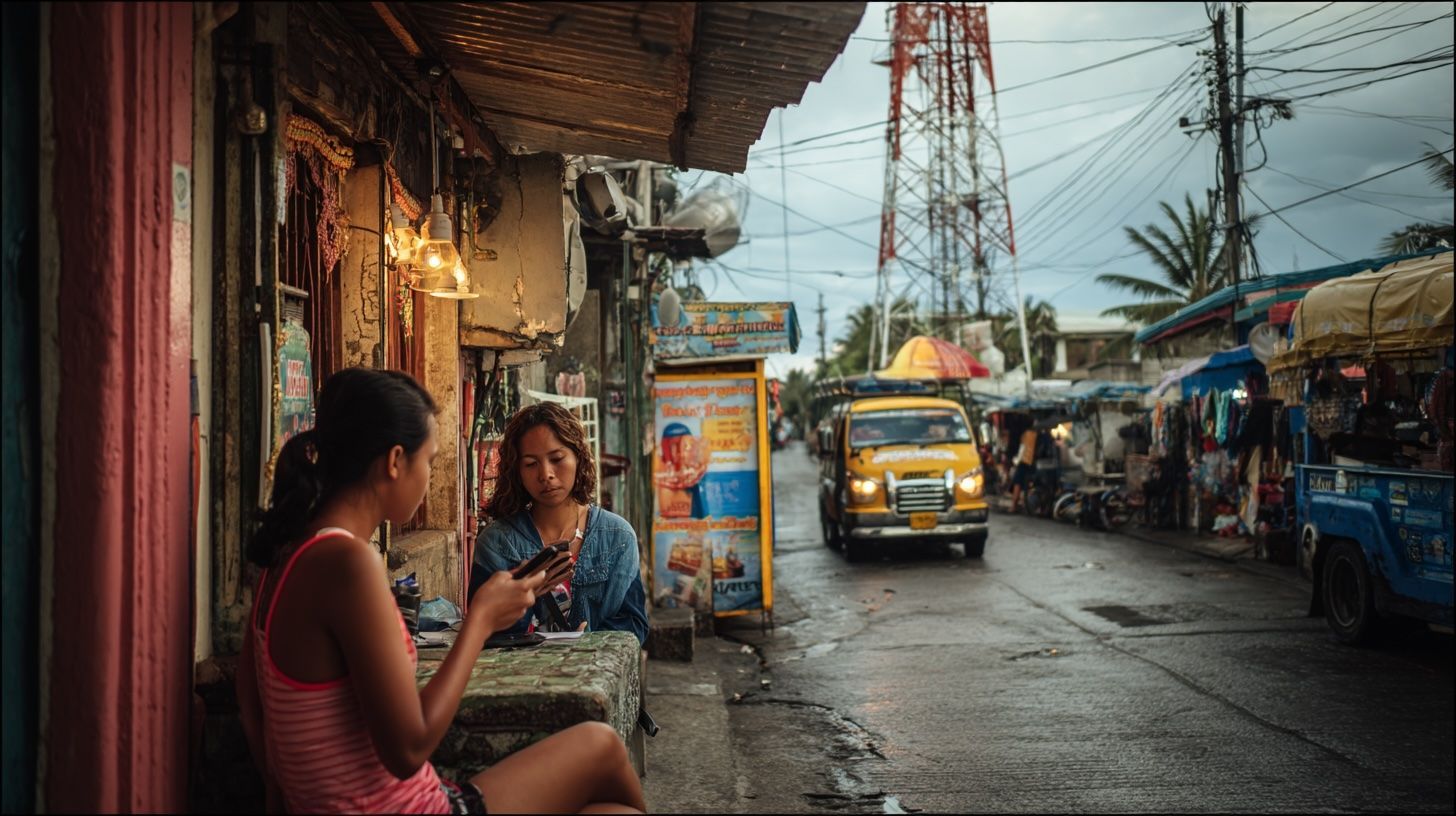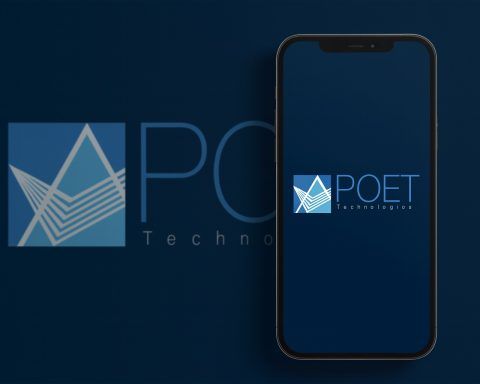- 2025年初頭の時点で約9,750万人がインターネットを利用しており、人口の約83.8%に相当する。
- フィリピンは7,600以上の島々からなる群島で、光ファイバー敷設とセル塔の建設が難しくなるため、都市部と農村部でインターネットの接続性が大きく不均一になっている。
- 固定ブロードバンドの加入者は2024年時点で約700万で、PLDTは2023年末時点でファイバーブロードバンド顧客約320万を持ち国内家庭用光ファイバーの約50%を占め、Converge ICTは2023年末までに加入者約210万、Globeは2024年時点で約174万。
- 固定ブロードバンドの速度は都市部でエントリプランが約50–100 Mbps、最高1 Gbpsのプランがあり、2025年初頭の平均下り・上りはともに約94.4 Mbps、メトロマニラの中央値は90 Mbps超、カラバソン南ルソンは約99.5 Mbps、東ビサヤは約38–40 Mbps。
- モバイル4G LTEのカバレッジは2023〜2024年時点で人口約99%、5Gカバレッジは約70%の人口に達し、2025年初頭の平均ダウンロード速度は約59 Mbps、アップロードは約9 Mbpsで、3G/2Gが依然残る。
- 2021年に新規参入したDITO Telecommunityは2024年9月時点で加入者1,300万(市場シェア約10%)を獲得し、4G/5Gを全国展開する一方、カバレッジは都市部中心で地方は遅れている。
- 衛星インターネットではStarlinkが2022年の外国人 ownership 緩和を経て2023年にサービス開始、全国カバー、月額₱3,800(2024–2025年)、機材₱29,000、速度50–200 Mbps、遅延20–50 ms、Kacific1は最大70 Mbps、遅延約600 ms、農村部の学校や自治体のバックホールに活用されている。
- 公衆Wi‑Fiは2023年時点で国内に13,000サイト以上、年末には15,000サイトへ拡大し、2028年には125,000サイトを目標、NAIAなど空港は50–60 Mbpsで3時間の無料Wi‑Fiを提供する。
- 観光客向けの通信は、空港でSmart・Globe・DITOのプリペイドSIMが購入可能で、₱500程度で1日〜30日データのパッケージが一般、eSIMとしてGlobe Travelerが利用でき、Pocket Wi‑Fiは日額₱200–₱300、SIM登録は2023年施行でパスポートが必要。
- 規制と市場構造では2022年の改革で外国人所有制の制限が撤廃され SpaceXのStarlinkなど新規参入が可能になりつつも、通信事業には congressional franchise が必要、DICTは国民ブロードバンド計画やPublic‑Private Partnershipを推進して都市部と農村部の格差是正を進めている。
国のデジタルインフラの概観とインターネット浸透率
フィリピンは過去数年間でデジタルインフラの拡大とインターネット利用の向上において大きな進展を遂げました。2025年初頭の時点で、推定9,750万人のフィリピン人がインターネットを利用しており、これは人口の約83.8%に相当します。この数字は過去の数十年からの劇的な増加を示しており、国のデジタル化への取り組みを反映しています。2024年までに、インターネット浸透率は人口の約84〜89%に達しており、多くのフィリピン人が何らかの形でオンラインで活動していることを示しています。
しかし、フィリピンの地理特性 – 7,600以上の島々からなる群島 – はインフラ構築に独自の課題をもたらしています。多くの島々や山間地、遠隔地に光ファイバーケーブルを敷設し、セルタワーを建設することは、困難で費用もかかる。これにより、インターネットインフラの発展は地域によって不均一になり、都市部では接続が強力である一方、多くの農村や遠隔地のコミュニティは信頼性のあるアクセスが欠けています。政府はインターネットを現代生活の基本要件と認識しており、「BroadBand ng Masa」プログラムやフィリピン開発計画2023–2028などのイニシアチブのもと、このデジタルギャップを解消することを優先しています。
インターネットユーザーの人口統計: 多くのフィリピン人はモバイルデバイス経由でインターネットにアクセスしていますが、家庭用ブロードバンドの使用も増加しています。国内のモバイルSIM浸透率は約123%(2024年末時点)で、これは多くのユーザーが複数のSIMを使用しているため、実際の人口を超えています。2024年末までにフィリピンには1億2,000万以上のモバイル加入者がいました。高い利用率にもかかわらず、人口の一部はまだオフラインのままです。DataReportalによれば、2025年初頭の時点で16%のフィリピン人(約1,800万〜1,900万人)がまだインターネットを使用していなかったと推定されており、その主な原因はアクセスや手頃な価格の問題です。
固定ブロードバンドの可用性と品質(ファイバー、DSL、ケーブル)
固定ブロードバンドの種類: 都市部では、光ファイバーブロードバンドが主流の固定インターネットサービスとなり、従来の技術であるDSLやケーブルインターネットを置き換えています。主要プロバイダーはメトロマニラや他の都市で家庭用光ファイバー(FTTH)を展開し、高速で無制限のデータを提供しています。DSL回線(銅線電話線)は一部の地域にまだ存在しますが、光ファイバーの拡大に伴い廃止されつつあります。そして、ケーブルインターネット(同軸TVケーブル経由のブロードバンド)は選択できる地域で利用可能ですが(たとえばSky Cableを通じて)、市場シェアは比較的小さく、しばしば光ファイバーサービスに比べて速度が遅いか制限があります。
カバレッジ: 固定ブロードバンドアクセスは都市中心部や主要な町に集中しており、農村部の自治体ではその可用性がはるかに低くなっています。2024年でも、メトロマニラの家庭の約26%が固定ブロードバンドを契約しており、隣接するCALABARZON地域では約23%でしたが、多くの農村県では一桁台のパーセンテージにとどまっています。全国的に見ても、固定ブロードバンドはまだ少数の家庭にしか届いていません。プロバイダーはより多くの地域に光ファイバーラインを拡大しようとしていますが、多くの遠隔地や人口の少ない地域は高額な展開コストのために無サービスのままです。
主要なファイバーネットワーク: 全国のファイバーバックボーンは急速に成長しています。PLDT Home (PLDT Inc.) – 親会社のPLDTは主要な通信企業であり、Converge ICT Solutions(新しい光ファイバ専用ISP)は広範なファイバーネットワークを築いています。Globe Telecomも多くの場所で光ファイバー(GFiberブランド)を展開しており、Sky Cableはハイブリッドなファイバーケーブルネットワークを維持しています。政府も同様に貢献しており、Luzon Bypass Infrastructureを完了しました。これはFacebookとのパートナーシップによるファイバーバックホールプロジェクトで、国内のファイバーバックボーンを強化します。
加入者: 2024年時点でフィリピンの固定ブロードバンド加入者は合計で約700万で、主要なプレーヤーに分かれています。PLDTが市場をリードしており、2023年末時点で約320万のファイバーブロードバンド顧客を持っており、国の家庭用光ファイバー加入者の約50%を占めています。Converge ICTは急成長し、2023年末までに210万以上の加入者を獲得し、2番目に大きな固定ブロードバンドプロバイダーとなっています。Globe Telecomは2024年に約174万の家庭用ブロードバンド加入者を持ち、一部のレガシー無線ブロードバンドユーザーを失ったために2023年の175万からわずかに減少しました。小規模なケーブルオペレーターや地元のISPが残りを占めています。これらの数字は、固定インターネットが成長している一方で、大部分の人口が家庭での接続にモバイルネットワークを依存しているか、家庭用インターネットを持たないことを示しています。
品質と速度: 利用可能な場所では、フィリピンの光ファイバーブロードバンドは世界基準に匹敵する高速を提供します。一般的な光ファイバープランはエントリーレベルのプランで約50–100 Mbps、プレミアムプランでは1 Gbpsまであります。実際、2025年には主要なISPが速度を倍増させています。たとえば、約₱1,299(フィリピンペソ)のプランでは速度が100 Mbps、約₱1,499のプランでは300 Mbpsの速度が提供されます。最高級の住宅用パッケージでは最大で1 Gbps(1000 Mbps)が提供されます。フィリピンの平均固定ブロードバンド速度は2025年初頭までに下り94.4 Mbps、上り94.4 Mbpsと測定され、わずか2年前からの+51%の大幅な改善です。この飛躍は、ファイバーネットワークの展開とアップグレードに起因しています。固定ブロードバンドの待ち時間(レイテンシー)は一般的に低く(国内接続ではしばしば20 ms未満)、ビデオストリーミング、オンラインゲーム、VoIPにも適しています。
もっとも、品質は地域によって異なります。メトロマニラやルソン州は最速の速度を誇り、上位地域の中央値の固定ダウンロード速度は90 Mbpsを超え、カラバソン(南ルソン)は中央値で約99.5 Mbpsを記録しています。対照的に、インフラが限られている地域のサービスはより遅く、たとえば東ビサヤ地域の固定ダウンロード中央値は約38–40 Mbpsです。サービスの信頼性は都市では一般的に良好ですが、自然災害(台風、地震)やケーブルの切断事故などで停電が発生することがあります。バックボーンの冗長性は改善されていますが、フィリピンが国際的な海底ケーブルに依存しているため、それらの海底リンクの故障や混雑が発生すると(過去に発生したことがある)海外接続が修復されるまで遅くなる可能性があります。総じて、カバー地域にいる場合、高速で低遅延のインターネットを提供する光ファイバーが最適な選択肢となります。
モバイルデータネットワーク(3G、4G、5G)の可用性と品質
モバイルネットワークは、ほとんどのフィリピン人にとっての主要なインターネットアクセス手段です。フィリピンは特に4G LTEの広範なモバイルカバレッジを有しています。2023年から2024年の時点で、大体人口の99%を4G LTE信号がカバーしており、事実上、すべての人が居住する地域は少なくともいくらかのモバイルインターネットアクセスを持っています。多くの小さな島々や農村部の村(バランガイ)も、群島全体にある数千の基地局のおかげで4Gあるいは旧式の3Gネットワークによってカバーされています。
3Gおよびレガシーネットワーク: 3G(UMTS/HSPA)は2000年代から2010年代にかけて広く展開され、依然として存在しますが、4Gによってますます取って代わられています。3つの主要なオペレーターはすべて、4Gが利用できない地域や基本的な電話での3Gサポートを継続していますが、3Gカバレッジは今や回避策として効果的に普遍的です。2G(GSM/EDGE)もいくつかの遠隔地では音声/SMS用に残っています。4G/5Gのスペクトラム転用計画が進行中ですが、2025年時点での主要な3Gシャットダウンは行われていません。
4G LTE: 国の4G LTEネットワークはカバレッジが強固ですが、速度と容量の問題に直面してきました。近年、プロバイダーはLTE-A(LTE-Advanced)機能とより多くの周波数帯を追加してパフォーマンスを向上させました。フィリピンの平均モバイルダウンロード速度は2025年初頭に約59 Mbpsと測定されました。これは大きな進歩であり(フィリピンでは数年前に平均がわずか17〜18 Mbpsだった)、ネットワークのアップグレードと競争の反映です。それにもかかわらず、モバイル速度は場所やプロバイダーによって大きく異なります。新しい設備を備えた都市地域と小さなセル半径の場所では高速(4Gで時には100 Mbpsを超える)ですが、混雑したり遠隔のセルでは最悪の場合5 Mbps未満になることもあります。モバイルのアップロード速度は平均でわずか~9 Mbpsと、ファイル送信やビデオ通話でボトルネックになることがあります。
近隣諸国と比較して、フィリピンのモバイルインターネット速度はシンガポールやタイのリーダーに大きく遅れを取っているのが現状です。2023年の調査によると、フィリピンのモバイルブロードバンドは平均ダウンロード約25 Mbpsとされ、当時のシンガポールの~81 Mbpsと比べはるかに低い数値でした。同じ調査はフィリピンにおけるモバイルデータの手頃さが課題であり、GSMAインデックスで47/100のスコアで東南アジアでの手頃さにおいて3番目に低いと指摘しました。つまり、カバレッジは幅広い一方で、容量とコストの改善の余地があります。
5Gネットワーク: 5Gはフィリピンで2019〜2020年に導入され、大きく拡大しました。2024年までに、5Gカバレッジが人口のおよそ70%に達し、主要都市や人口密集地域に集中しています。PLDT-SmartとGlobeの両社はメトロマニラ、セブ、ダヴァオ、他の主要都市で5G基地局を積極的に展開しました。5Gははるかに高い速度を提供し、フィリピンの5Gユーザーは良好な条件でしばしば100–500 Mbpsのダウンロード速度を享受し、遅延はさらに低い(約10–15 ms)です。しかし、5Gカバレッジは依然として都市部外では部分的です。旅行者は市の中心部や空港、発展地区で5Gを利用できるかもしれませんが、地方の町に移動すると電話はおそらく4Gか3Gに戻ります。3番目のプレイヤーDITOも限られた地域で5G(主に固定無線アクセス用)の展開を開始しました。5Gの普及が続く中で、特に都市部でさらに速いモバイルインターネットを期待できます。
ネットワークの品質と競争: 2021年に新しい通信会社(DITO)が参入し競争が活性化しました。現在は全国的にサービスを提供する3つのオペレーターが存在しています(詳細は次のセクションに記載)。独立した分析(例えばOpenSignalによると)、Smart(PLDT)が4Gの速度と遅延メトリックでしばしばリードし、Globeは広範なカバレッジリーチへの投資を行っています。興味深いことにDITOは新しいネットワークを持ち、当初はユーザーが少ないため、サービス地域では非常に高速な速度を示すことがあり、2023–24年の最速モバイルネットワークの賞を受賞しました。実際には、SmartとGlobeははるかに多くのセルサイトとスペクトラムを持っているため、より多くの地域をカバーし、DITOのネットワークは新しくも未完成のカバレッジギャップを埋めています。都市部のユーザーは3つの選択肢がありますが、農村部のユーザーはSmartまたはGlobeのみを選択するのが現実です。
全体として、フィリピンのモバイルインターネットの信頼性は向上していますが、依然として一貫していない場合があります。州では、タワー容量の制限によってピーク時に通話が途切れたりデータが遅いことがあります。地形関連の課題(山岳地帯、島々)により一部のコミュニティでは信号が弱く、単一のタワーに依存していることがあります(そのタワーがダウンすると停電が発生します)。政府の「共通タワー」政策は、渋滞を緩和しカバレッジを拡大するためにタワー企業による数千の新しいセル塔の建設を奨励しています。これが進行中であり、新しいタワーが稼働し4G/5G機器が追加されることで、フィリピン全国でモバイルネットワークの品質が徐々に向上しています。
主要なインターネットサービスプロバイダー(ISP)および通信オペレーター
フィリピンの通信市場は長い間、PLDTとGlobeのデュオポリーによって支配されていましたが、2021年以降、第三者である(DITO)が参入し、いくつかの専用ブロードバンドISPが登場しました。以下はインターネットアクセスを提供する主要な会社です:
- PLDT Inc.(およびSmart Communications) – PLDTはフィリピンの以前の独占電気通信会社であり、固定およびモバイル市場で主要なプレイヤーの一つです。その家族部門PLDT Homeは全国でのファイバーブロードバンド(「PLDT Fibr」または「Fiber Unli」としてブランド化)を提供し、2023年にはファイバー加入者が約320万人(ファイバー市場の50%のシェア)でした。PLDTは最も広範な国内ファイバーバックボーンと国際海底ケーブルへの投資を持っています。モバイル面では、そのワイヤレス部門Smart Communicationsはトップ2のモバイルオペレーターの一つで、2024年末には約6,030万モバイル加入者(市場の約45%)を有しています。Smartは2G/3G/4G/5Gを全国展開し、市場では一般に高速データ速度と幅広いカバレッジが評判です(特にレガシーインフラのおかげで僻地でも広範囲カバー)。PLDT/Smartは企業向け電気通信サービスを提供し、地球規模インターネット座礁に接続する多くの海底ケーブルの持分も所有しています。
- Globe Telecom – Globeは他の長年の主要な電気通信企業で、2024年には同じく約6,000万モバイル加入者(約45%のシェア)を持っています。広範な4G LTEネットワークと成長中の5Gネットワークを運営しており、歴史的に都市部と消費者市場で強みがありました。Globeのモバイル製品にはGlobeブランドやTM(Touch Mobile)があり、低予算ユーザー向けが存在します。固定部門ではGlobe At Homeがファイバー(GFiber)を通じてブロードバンドを提供、また固定無線も利用可能です(彼らはHome Prepaid Wi-Fi 4Gルータサービスを普及させました)。Globeの家庭ブロードバンド加入者数は約174万人で、ファイバーと固定無線加入者を含んでいます;会社はこれらの多くをファイバーに移行することを目指しています。Globeは自社の海底ケーブル持分とパートナーシップを通じた国際的な帯域幅を持っています。近年、Globeはデジタル決済(GCash)や他のデジタルサービスにも多角化し、接続ビジネスを補完しています。
- DITO Telecommunity – DITOは新たに、大手通信企業のひとつとして政府に支持されて2021年に商業活動を開始した「第三者電気通信会社」としてデュオポリーを突破しました。中国およびフィリピンの投資企業によりバックされています。DITOは4G/5Gネットワークをゼロから構築しました。2024年9月までに1,300万モバイル加入者(約10%のシェア)を獲得し、短期間で急速に増加しました。DITOのネットワークはすべて現代のインフラを使用しており:4G LTEを提供し、5Gを拡張中であり、2G/3Gレガシーがありません。OpenSignalでの報告では、DITOは4Gの可用性やダウンロード速度全体において、まだ少ないユーザー数のため一部のエリアで非常に速い速度を示しており、他社が取り扱っていない一部エリアにターゲティングされた可能性があります。しかし、DITOのカバレッジはまだ追いついておらず、主要都市と多くの町をカバーしていますが、一部の地方はまだサービスされていません。当初、PLDT/Globeのネットワークへのインターコネクトで課題に直面し、タワー展開のスケーリングに取り組んでいました。2025年の時点では、DITOは主にモバイルデータプロバイダーではありますが、選ばれたエリアで5G固定無線ブロードバンドを提供し始めていますが、有線ブロードバンドプレイヤーとしてのシェアはまだわずかです。DITOの参入は競争相手を改善する動機を与え、消費者に有益となっています。
- Converge ICT Solutions – Convergeは、固定ブロードバンドISPとして著名なプレイヤーです(モバイルサービスは提供していません)。2007年に設立され、全国で純粋な光ファイバーブロードバンドの展開に注力しました。Convergeのネットワークは現在、多くの州に広がっており、しばしばサービスが不十分な二次都市連や町をターゲットにしています。2023年末までにConvergeは210万以上のファイバー加入者を持ち、PLDTに次ぐ2番目に大きな固定ブロードバンドプロバイダーになっています。実際に、最近の数年間、新たなファイバーの加入者において大きなシェアを主張しており、住宅用ファイバーマーケットではGlobeを上回っています。会社は競争力のある価格を提供しており、初めて低所得者向けのプリペイドファイバープラン(Surf2Sawa)を導入しました。LuzonとVisayas/Mindanaoの一部での存在感が最も強く、拡張を続けています。Convergeは従来のDSLやケーブルを持たず、全てがファイバーであるため、一貫して高速度を提供する助けとなっています。調査では、Convergeはしばしば固定ISPの中で信頼性で高評価を得ています。Convergeでカバーされているエリアでは、それはPLDT/Globeに対する価値ある代替であり、ファイバーマーケットの価格を下げる役割を果たしています。
- Sky Cable(Sky Broadband) – Skyは(かつてABS-CBNが所有していた)ケーブルテレビ会社であり、都心部でケーブルブロードバンドと一部のファイバーも提供しています。Skyは全盛期で数十万のブロードバンド加入者(30万〜40万程度)に規模を持っていました。2023年には、PLDTがSkyのブロードバンドビジネスを市場の統合のために買収を試みましたが、規制と競争の懸念からその取り引きは中止されました。ConvergeがSkyの資産を代わりに取得する可能性があるという報告もありましたが、2025年の時点でSkyは小さな独立ISPとして残っています。Skyのブロードバンドは主にメトロマニラや一部都市ではDOCSISケーブルラインを通じて提供され、大抵は50〜200 Mbpsのプラン速度を持っています。その範囲は基本的に農村部には及びません。
- その他: 少数の他プレイヤーが存在するが範囲は限られています。Now Telecomはメトロマニラで小さな固定無線ネットワークを運営しています。Eastern Communicationsは企業向けインターネットと一部のマニラのマンションにファイバーを提供しています。RiseやINFINIは選ばれた都市での企業用ファイバーを提供します。また、多くの地域ケーブル事業者や協同組合が県庁町で非常に小規模にインターネットを提供しています。政府はDICTを通じて、国民ブロードバンドネットワークを構築しており、最終的にはテルコには収益性がないとされるエリアに特に卸売業者またはバックボーンとして機能する可能性があります – これはまだ進行中です。全体として、上記のISPが国内でのインターネット加入の大部分を占めています。
市場構造: フィリピンの通信業界が少数のプレイヤーによって支配されていることには長所と短所があります。大手テルコ(PLDTとGlobe)はインフラ(国際ケーブル、全国ファイバーバックボーン、数千のタワー)に多額を投資してきましたが、小規模ISPはしばしば容量を彼らから借りたりインターコネクトを交渉する必要があり、新規参入の障壁になり得ます。2022年の規制改革により電気通信会社の外国人所有制限が撤廃され、理論的にはさらなる外国投資と新規参入を可能にしました – notable this enabled companies like SpaceX (Starlink) to operate in the Philippines. Still, new entrants face hurdles like needing a congressional franchise for telecom services, a requirement unique to the Philippines. The government has been pushing policies to improve competition and infrastructure – such as easing permits for tower construction, encouraging network sharing, and pursuing Public-Private Partnerships for broadband projects. These efforts are gradually bearing fruit in the form of more choices and better service for consumers.
Regional Disparities: Urban vs. Rural Connectivity
A notable aspect of internet access in the Philippines is the digital divide between urban and rural areas. Generally, urban regions – especially Metro Manila, Metro Cebu, Metro Davao, and regional city centers – enjoy far better connectivity than rural towns, remote islands, and highland villages.
Several factors drive this disparity:
- Infrastructure concentration: Telecom companies naturally prioritize densely populated and economically active areas. Thus, fiber networks and cell towers are heavily concentrated in cities and along main highways. Rural areas, with their low population density, see less investment because the cost per user is higher (long distances for cables or more towers needed to cover few people). For example, Metro Manila might have multiple fiber providers competing in one neighborhood, whereas a small island barangay may have no fiber at all and perhaps a single 4G tower serving the whole area.
- Geographic challenges: The Philippines’ rugged terrain and island geography mean some communities are literally hard to reach. Mountainous provinces and far-flung islands (think parts of the Cordilleras, Mindoro’s interior, or island groups like Batanes, Sulu, etc.) face more difficulty getting cables and stable signals. Microwave relays and undersea cables are needed to connect islands – some small islands rely on radio links or satellite, which can be slower or more costly.
- Economic factors: Rural incomes are generally lower, which affects affordability of services. Even if a network exists, fewer rural households might subscribe to a home broadband plan due to cost. This in turn makes companies less eager to expand there, perpetuating the cycle. The PIDS (Philippine Institute for Development Studies) found that although mobile data has become more affordable in recent years, the Philippines still ranks low in mobile data affordability relative to other ASEAN countries. This especially impacts rural and poor communities.
- Access to devices and electricity: Aside from network availability, some rural residents lack internet-capable devices (smartphones, computers) or stable electricity. This contributes to roughly 16% of Filipinos remaining offline in 2025. Government and private programs are trying to address this by distributing gadgets and solar power solutions in remote learning centers, etc., but challenges remain.
Impact on quality and speeds: The urban-rural divide is clearly seen in speed statistics. As noted, Luzon regions dominate the speed charts (e.g., CALABARZON’s median fixed broadband is ~99 Mbps), whereas poorer, more rural regions lag far behind. A study highlighted that Region VIII (Eastern Visayas) has fixed broadband speeds around 40 Mbps max, and the BARMM region in Mindanao averages barely 10 Mbps on mobile. Those are a fraction of the speeds enjoyed in Manila or Cebu City. In some remote towns, users might be on 3G connections that deliver only 1–2 Mbps in practice, just enough for basic messaging but not for heavy media use.
Coverage gaps: In terms of basic access, most of the Philippines has at least some mobile coverage, but there are still dead zones – typically small interior villages or mountainous areas where signals from the nearest tower don’t reach. Also, some remote islands are covered only by 2G voice or very weak data. The government acknowledges that around 40% of the country lacks reliable internet access (meaning they may have some signal but not at acceptable quality). For instance, in parts of western Mindanao and Eastern Visayas, internet penetration rates are dramatically below the national average – the Caraga region in Mindanao reportedly had only about 17% internet penetration as of a recent assessment. This shows how certain communities remain effectively disconnected from the online world’s opportunities.
Bridging the divide: Efforts are underway to narrow these disparities. The DICT’s Free Wi-Fi for All programspecifically targets public places in geographically isolated and disadvantaged areas (GIDAs). The National Broadband Plan and projects like the Philippine Digital Infrastructure Project (with World Bank funding) are focused on extending backbone fiber and satellite connectivity to remote provinces. There are also calls for innovative solutionssuch as community networks, TV white space broadband, and lower satellite broadband costs for rural areas. Private telcos have been encouraged to partner on infrastructure sharing – e.g. co-locating on towers and sharing fiber backhaul – to make rural expansion more cost-effective.
It’s a long road ahead, but the gap is slowly closing. Mobile broadband is the immediate savior for many rural folks – with nearly universal 4G coverage, even if speeds are not great, a basic level of connectivity is present. And as new technologies (5G, LEO satellites, etc.) become more widespread, there is optimism that even remote Philippine communities will eventually get online with decent service.
Satellite Internet Availability (Starlink and Others)
Given the Philippines’ terrain and dispersed islands, satellite internet is an important option to reach areas where terrestrial networks are absent or unreliable. In the past, satellite internet in the Philippines was limited to very expensive, enterprise VSAT services. But recently, new players and technologies have made satellite connectivity more accessible:
- Starlink (SpaceX): The Philippines was one of the first countries in Asia to approve SpaceX’s Starlink service. In 2022, regulators allowed 100% foreign-owned Starlink operation, and by early 2023 Starlink satellite internet became available in the Philippines. Starlink uses a constellation of low-earth orbit (LEO) satellites to deliver broadband. Coverage: Starlink covers the entire country (everywhere with a view of the sky), which is transformative for remote areas like small islands, mountains, ships at sea, etc. Speed: Users report speeds around 50–200 Mbps down and 10–40 Mbps up, with latency 20–50 ms – far better than older satellite systems. Cost:Initially, Starlink’s residential service cost ₱2,700 per month with a hefty equipment fee (₱29,000 for the dish kit). As of 2025, the monthly rate increased to ₱3,800 (about $70) per month for unlimited usage, while equipment is sometimes discounted (recent promo at ₱19,999 for the kit) to around $350–400. This pricing is steep for average Filipinos, but for businesses or communities in off-grid areas it can be worthwhile. The DICT has even looked at using Starlink to improve government connectivity in remote regions. Starlink has both fixed and “Roam” plans in the Philippines; some resorts in remote tourist spots (e.g. islands in Siargao, Palawan) have started installing Starlink to provide Wi-Fi to guests where no other broadband exists.
- Kacific: Another notable provider is Kacific1, a high-throughput geostationary satellite covering the Philippines and Pacific. Kacific offers satellite broadband via VSAT to rural communities, often in partnership with local ISPs or cooperatives. Its service has been used to connect remote schools, clinics, and local government units. While latency on Kacific (being GEO) is higher (~600 ms), it can deliver decent speeds (up to 70 Mbps download in ideal conditions). The cost per month can be tailored (some plans aimed at community Wi-Fi hubs). Kacific has actively worked with the Philippine government’s Free Wi-Fi program – for instance, providing satellite backhaul to connect public Wi-Fi hotspots in areas with no fiber or cellular backhaul. This has been crucial for certain isolated barangays.
- Other satellite services: Traditional VSAT providers like IPStar, SES, and Inmarsat have long had presence in the Philippines for enterprise, maritime, and government use (e.g., disaster response communications). These typically involve installing a 1.2m or larger dish and subscribing to costly plans. They are not commonly used by individual consumers due to cost. However, some small Internet cafés or businesses in far-flung islands do use VSAT where nothing else is available. There is also OneWeb, another LEO satellite constellation, which may start services via partners in Southeast Asia soon – but as of 2025, Starlink is the only widely available LEO option for the PH.
In summary, satellite internet is now a viable solution in the Philippines for those who truly need it. Starlink, though expensive, can bring high-speed internet to a fishing village on an island that otherwise only had 2G phone service. The government’s policy of “satellite service liberalization” (making it easier for companies to offer satellite broadband) is expected to increase these options. Over time, as competition and technology improve, satellite broadband costs may come down, potentially making it an option not just of last resort but a competitive alternative even in mainland areas.
For most consumers, satellite won’t be the first choice due to cost and the need to install equipment. But for remote area connectivity, it is a game-changer. Tourists visiting very remote resorts or digital nomads in rural locales might also encounter Starlink-powered Wi-Fi as part of their stay, which significantly improves the experience compared to the old days of no signal at all.
Public Wi-Fi Access in Airports, Malls, and Tourist Areas
Public Wi-Fi hotspots are common in the Philippines, provided both by government initiatives and private enterprises. These can be very useful for travelers and residents who need internet on the go or lack a personal connection. Key places to find free or public Wi-Fi include:
- Airports: All major airports in the Philippines offer free Wi-Fi for passengers. For example, Ninoy Aquino International Airport (NAIA) in Manila has airport-wide free Wi-Fi that was recently upgraded. As of late 2024, passengers at NAIA can access free Wi-Fi for up to 3 hours (previously 2 hours) without needing to fill out personal information forms. The speeds at NAIA are quite good: averaging 50–60 Mbps and peaking at over 100 Mbps in the terminals – enough for video calls or streaming while waiting for a flight. This improvement came after the management (MIAA) partnered with PLDT-Smart and Converge to install more access points and bandwidth at all NAIA terminals. Other international gateways like Cebu-Mactan Airport, Clark Airport, Davao Airport, etc., also have free Wi-Fi, usually provided by one of the telcos. For instance, some airports have Globe-sponsored Wi-Fi zones, others Smart, etc. Typically, you connect to the “[Airport]_FreeWiFi” SSID and either get a time-limited session or need to watch an ad or enter an email. Smaller domestic airports might have more limited coverage (e.g. only in departure lounges) and sometimes the speeds are slow if many users are on, but the trend is toward improving these services.
- Malls and Cafés: The Philippines is known for its large shopping malls, and these are almost always equipped with Wi-Fi. Malls (SM, Ayala, Robinsons, etc.) offer free Wi-Fi in common areas. Often the network is sponsored by a telco – for example, “Globe Free Wi-Fi @ [Mall]” or “SM Free WIFI (powered by Smart)”. Access usually requires a one-time signup on a portal and may be limited to 30 minutes to 1 hour of free use per device per day. Some mall Wi-Fi is quite fast (20–50 Mbps) especially when not too crowded. In addition, nearly every coffee shop, fast food outlet, and co-working space in cities provides Wi-Fi for customers. For instance, chains like Starbucks, McDonald’s, and many local cafés offer free Wi-Fi (sometimes you need to ask for a login code on your receipt). Tourists will find that in urban centers, it’s easy to hop online at cafés and restaurants – though security-wise, remember these are open networks, so use a VPN if doing sensitive work.
- Public Transport Hubs: There have been efforts to provide Wi-Fi in transportation hubs. Major bus terminals and seaports in cities often have some form of Wi-Fi (e.g., the PITX bus terminal in Metro Manila has free Wi-Fi for passengers, and some provincial bus stations do too). On MRT/LRT train lines in Manila, there were pilot programs to add Wi-Fi in stations and even inside trains, though the quality was hit-or-miss. Some new point-to-point buses offer Wi-Fi on board. These are conveniences but not guaranteed everywhere – a lot depends on the specific operator or local government.
- Tourist spots and city centers: The government’s DICT has been installing Free Wi-Fi hotspots at public parks, plazas, and tourist attractions under the Free Wi-Fi for All Act. For example, in Boracay (a prime tourist island), the government set up free public Wi-Fi along White Beach and other key areas. If you’re in popular areas of Manila like Rizal Park or BGC, you may find a “Free Public WiFi” network. The connectivity and speed on these can be quite variable – they’re often on limited backhaul. But they do help those without mobile data to check messages or maps. As of mid-2023, the DICT reported over 13,000 live free Wi-Fi sites nationwide, scaling up to 15,000 sites by end of 2023. These include public schools, libraries, barangay halls, rural health units, parks, plazas, and tourist spots. The goal is an ambitious 125,000 free Wi-Fi sites by 2028, which would blanket much more of the country. Notably, about 10 million user devices have been recorded using these free Wi-Fi networks, indicating high demand.
- Private sector hotspots: Outside of free access, there are also paid Wi-Fi hotspots and community networks. You might encounter something called “Piso Wi-Fi” – coin-operated Wi-Fi vending machines popular in some neighborhoods. These are essentially routers where users drop coins (e.g., ₱5 for 30 minutes of internet) and connect to the hotspot. They’ve become a grassroots way to share internet in poorer communities where not everyone can afford their own plan. Tourists likely won’t use these much, but it’s interesting to note as part of the local connectivity landscape.
Using public Wi-Fi: For travelers, public Wi-Fi is a great backup when you’re low on data or don’t have a local SIM yet. Airports are a first stop – NAIA’s improved service means you can easily book a Grab ride or notify contacts online upon arrival. In malls or cafés, it’s convenient to use their Wi-Fi to download large files or upload photos to the cloud. Just keep in mind standard precautions: these networks are open or shared, so avoid accessing sensitive banking info without safeguards. Also, some free Wi-Fi require registration via a local mobile number (they text you a code). This is the case in certain airport or mall setups. If you don’t yet have a SIM, you might be able to ask the info desk for a voucher login, or use an international number if supported. The Inquirer reported that NAIA’s Wi-Fi no longer requires personal info as of 2024, which shows the move toward more user-friendly access.
In summary, public Wi-Fi is widely available in Philippine urban life – in fact, Filipinos often expect it as a basic amenity in establishments. Tourists can take advantage of it at airports, major transit points, and commercial areas. For connectivity in between, a combination of local SIM data and these Wi-Fi hotspots will keep you online almost everywhere a traveler typically goes.
Internet Options for Tourists: SIM Cards, eSIMs, and Pocket Wi-Fi
For visitors to the Philippines, getting connected is relatively easy and affordable. Here are the main internet access options and tips for tourists:
1. Local Prepaid SIM Cards: Buying a local prepaid SIM is the most popular choice for tourists needing internet on their phones. The Philippines’ three mobile networks (Smart, Globe, and DITO) all offer prepaid SIM cards for sale at airports and in town. Upon arrival at major airports like NAIA (Manila), Mactan-Cebu, Clark, Iloilo, Kalibo, etc., you will typically find telco kiosks or sales reps offering Tourist SIM packs. These often come with some free data or promos included.
- Smart Prepaid SIM: A Smart tourist SIM pack might cost around ₱500 (roughly $9 USD) and often includes a generous promo, for example 1 GB of data per day for 30 days, plus unlimited social app access [1]. Smart’s network is extensive, covering practically all provinces. For travelers planning to visit rural areas or many islands, Smart is a strong choice due to its generally wider coverage in remote spots.
- Globe Prepaid SIM: Globe likewise has tourist SIM offers. Sometimes the SIM itself is free at the airport (Globe has been known to give free SIMs to incoming tourists), and you then load it with a surf package of your choice. Globe’s tourist bundles might include, say, 8 GB for 7 days or special social media perks. Globe’s coverage is also nationwide (very good in cities and tourist hotspots; decent in most rural areas, though there are a few places where only Smart has signal). Globe touts its higher subscriber count and often positions itself as having a user-friendly app (GlobeOne) to manage your prepaid account.
- DITO SIM: DITO is newer and may not have as obvious a presence at airports yet, but their SIMs can be bought in electronics shops or convenience stores for about ₱40–₱50. DITO’s regular offers are very affordable (e.g., ₱49 for 3 GB data + on-net calls/SMS). The catch is that DITO’s coverage is still not universal – they are fine in many city areas and some secondary towns, but if you go off the beaten path, you might lose DITO signal. Tourists sticking to major cities could consider DITO for its cheap rates, but if your itinerary includes remote beaches or mountains, use Smart or Globe to be safe.
SIM Registration: Important: The Philippines implemented a SIM Card Registration Act in 2023 requiring all SIMs to be registered to a user with valid ID [2]. As a tourist, you can register your prepaid SIM using your passport. The telco staff at the airport will usually assist with this – they might have you scan a QR code to fill out a form or they do it on a tablet. It’s not a very time-consuming process, but be prepared to show your passport and visa details if asked. Unregistered SIMs eventually get deactivated, so make sure you complete registration when you buy the SIM. If buying from a store, ask how to register – some have online portals or will register it on the spot.
2. eSIM (Digital SIM): If you have an eSIM-capable phone, you might be able to get service without needing a physical SIM card. Globe offers a Prepaid eSIM for travelers – you can purchase the Globe Traveler eSIM online (through the GlobeOne app or website) even before you arrive. This lets you scan a QR code and instantly activate a Philippine number with a data plan. It’s very convenient for those who don’t want to fumble with SIM trays after a long flight. Smart has also started to pilot prepaid eSIMs, though as of mid-2023 some travelers noted Smart’s tourist eSIM was still in trial phase. By 2024, these options are becoming more mainstream. Additionally, international eSIM providers like Airalo, Nomad, Holafly, etc., offer regional or country-specific plans – these use the local networks (often Globe) via roaming agreements. For example, an eSIM from Airalo for the Philippines might cost ~$15 for 5 GB. If you want everything set up the moment you land, an eSIM is superb – you could enable it on the plane and have data as you step off. Do note, eSIMs will also need to be registered (the process will usually ask for passport info digitally).
3. Pocket Wi-Fi Rental: If you have multiple devices or are traveling in a group, renting a Pocket Wi-Fi (portable hotspot) can be a good solution. Several companies at the airport and in cities rent out these small battery-powered Wi-Fi routers. They contain a local SIM and create a Wi-Fi network that you and your companions can connect your phones/laptops to. Rates vary, but typically it might be around ₱200–₱300 per day (around $4–6/day), often with “unlimited” data (fair use caps may apply). Some rental services require a deposit or credit card hold. You can reserve pocket Wi-Fi units online (there are Filipino companies like Flytpack, and even international sites like Klook offer Philippines pocket Wi-Fi rental bookings). This option saves each person from needing a separate SIM, and avoids fiddling with phone settings – you just carry the hotspot in your bag. The downsides: one more gadget to charge, and if you go separate ways from your group, you’re all dependent on that single device for connectivity. Overall, for a family or a short trip with multiple devices, pocket Wi-Fi can be cost-effective and hassle-free.
4. Using Roaming: While not a local option, it’s worth noting that major Philippine telcos do have roaming agreements. If you have an international roaming plan from your home country, you might get coverage on Smart or Globe networks. However, roaming is usually much more expensive (often $10+ per day or per GB). Unless your carrier offers a special roam-like-home deal for the Philippines, it’s generally better to use a local SIM or eSIM.
Setup and usage tips:
- Where to buy: It’s easiest to get SIMs at the airport arrival halls – you’ll often see stands for Globe, Smart, maybe others. They might have special tourist SIM packages ready to go. If you miss that, you can buy SIMs in 7-Eleven, mini-marts, phone shops, malls, etc. SIMs are cheap (₱40-₱100) and widely available, but note that as of 2023, vendors will ask for your ID to register the SIM. Ensure your phone is unlocked for other networks before you travel, so a local SIM will work.
- Loading and promos: Prepaid SIMs need to be “loaded” with credit (pesos) which you then convert into data packages or use as pay-as-you-go. You can load at any convenience store or kiosk (just give your number and pay cash, they’ll transfer load electronically), or buy scratch cards. Dialing
*123#(for Smart) or using the GlobeOne app (for Globe) are common ways to register for promos. Some popular tourist-friendly promos: Smart’s Giga or Unli Data offers, Globe’s GoSURF/Go offers, etc. For example, Smart has had an Unli Data 499 (₱499 for 30 days unlimited data) for select users, and Globe often offers Go90 (₱90 for 8 GB/7 days) or the like. It’s best to ask the sales rep which promo is ideal for your stay and usage – they might activate it for you on the spot. - Coverage considerations: If your travels include remote areas (trekking in Cordilleras, diving in remote islands, etc.), Smart is often recommended for better coverage in rural zones. Globe does cover many remote tourist sites too (they have cell sites in popular islands and highways), but there are anecdotes of one network working better than the other in specific spots. DITO, while improving, should be considered only if you’re staying in major towns. It’s not yet reliable in off-grid areas.
- SIM/eSIM validity: Prepaid SIM cards remain active for a long time as long as you keep them loaded (typically they expire after ~1 year of no load). So if you plan to return, you can keep the SIM. E.g., a Globe eSIM can be retained for future trips if you keep the account active by topping up occasionally.
By obtaining a local SIM or eSIM, tourists can enjoy very affordable data rates compared to international roaming. As a reference, a tourist could get around 30 GB of data for ₱500 (≈ $9) which is plenty for a 2-week trip [3]. Plus, having a local number is useful – you can receive one-time PINs for Grab rides, book local services, or call domestic numbers.
In case one doesn’t want to bother with local telecoms, many hotels, cafes, and malls (as noted in the Public Wi-Fi section) offer Wi-Fi. But relying solely on Wi-Fi might be inconvenient when out and about. So the best practice is: get a local SIM/eSIM for primary connectivity, and supplement it with public Wi-Fi when available to save data.
Typical Pricing for Internet Plans (Mobile, Broadband, and Tourist Packages)
One of the positives for internet users in the Philippines is that prices for data have been trending downward due to competition and improvements. Here we’ll break down typical costs in three categories: mobile data plans, home broadband subscriptions, and short-term tourist packages.
Mobile Data Plan Pricing: Mobile internet in the Philippines is generally prepaid and quite affordable by global standards (though still a burden for lower-income users). According to one global comparison, the average cost of 1 GB of mobile data in the Philippines is about $0.59 (59 US cents) [4], ranking it among the cheaper countries for data. In practice, nobody buys just 1 GB – instead, users take advantage of bucket promos:
- Prepaid promos: Both Globe and Smart offer a plethora of data packages. For example, ₱50 (around $0.90) might buy a 3-day promo with 1 or 2 GB of data plus free Facebook access. For heavier use, ₱299 ($5) can buy ~24 GB valid for a month (like Globe’s GoBOOST or Smart’s GigaPower offers). There are even unlimited mobile data promos: Smart has occasionally offered Unli Data for ₱499 (30 days unlimited) to select subscribers, and DITO has an affordable ₱699/month unlimited promo when within DITO coverage. On average, many Filipinos spend ₱300–₱600 per month ($5-$11) on mobile load which provides them enough data (10–30 GB) plus calls/texts. Postpaid plans (with a monthly bill) exist too, but these often bundle other perks; for pure data, prepaid is more common and cost-effective.
- 5G home wireless: As an alternative to wired broadband, Globe and Smart offer 5G fixed-wireless plans. For example, Globe’s Home Prepaid WiFi (4G LTE or 5G modem) can be loaded with an “UNLI 5G” data promo for ~₱599/30 days in areas with 5G coverage. Smart’s equivalent (Smart Bro Home WiFi) has similar pricing. These give unlimited or large data caps for use in a home router, providing a basic home internet via cellular network for those who can’t get fiber. Speeds on these can be very good in 5G areas (upwards of 50–100 Mbps), but can slow if the cell is congested.
Overall, mobile data is cheaper than calls or SMS now (which have largely been supplanted by messaging apps). Relative affordability: While $0.50/GB sounds great, remember the average Filipino income is lower; in fact the GSMA index cited earlier shows data eats a bigger share of income in the Philippines than in, say, Malaysia or Thailand. To address this, telcos continue to offer freebies (like free Facebook or TikTok data in promos) and smaller load denominations (you can load as low as ₱10 for one-day internet on some networks).
Home Broadband Pricing: Fixed broadband (fiber) is priced in tiers by speed. Compared to many Western countries, Philippine broadband is reasonably priced for unlimited data plans, thanks to competition among PLDT, Globe, and Converge. Here are typical price points for fiber plans as of 2024–2025:
- Entry-level fiber (speed for smaller households): ₱1,299 per month (~$23) for ~50–100 Mbps unlimited. Some providers offer 100 Mbps at this price now, after recent speed upgrades. Globe has a 50 Mbps @ ₱1,299, Converge and PLDT have 100 Mbps @ ₱1,299 in some areas.
- Mid-tier family plan: ₱1,499–₱1,699 per month (~$27–30) for ~300–500 Mbps unlimited. For example, Converge’s popular plan is ₱1,500 for 300 Mbps, PLDT offers 300 Mbps around ₱1,699, Globe 150 Mbps @ ₱1,699 or 300 Mbps @ ₱1,699 (they differ slightly but competition forces them to match closely). These plans are common for families streaming on multiple devices.
- High-tier plans: ₱2,000–₱2,800 per month ($35–50) for 500–800 Mbps. Typically ₱2,099 might get 500 Mbps (PLDT), and ~₱2,799 could get 800 Mbps on a Time-of-Day scheme or flat. Sky Cable has some unique plans like 150 Mbps day/150 Mbps night for lower cost, etc., but pure fiber usually is flat rate speeds.
- Top-tier/Gigabit: ₱3,500–₱5,000+ ($60-$90+) for 1 Gbps plans. Globe’s 1 Gbps is ₱4,999, PLDT has a 1 Gbps at ₱3,499 (promo) or their 1.5 Gbps at ₱7,499. These are obviously aimed at power users or offices.
Installation fees are often waived during promotions, and the standard contract is no-lock or 1-year lock depending on provider. It’s worth noting that these prices have dropped or speeds increased in recent years – e.g., a plan that was 100 Mbps for ₱1,699 two years ago might now be 300 Mbps for the same price. ISPs frequently upgrade customers for free to stay competitive.
For those areas without fiber, older DSL or satellite plans might cost similar amounts for way less speed (e.g., ₱1,000 for 5 Mbps DSL), but those are fading out as fiber becomes available.
Tourist and Short-Term Access Costs: We covered in the tourist section the SIM costs – to reiterate:
- A tourist SIM at the airport may be free or up to ₱50, with an initial pre-loaded promo to get you started. You’ll then spend maybe ₱500–₱1000 ($9-$18) on loading data depending on your length of stay and usage. For instance, ₱500 can buy a month’s worth of data (as mentioned, ~1 GB per day for 30 days on Smart [5], or ~15–20 GB on Globe). In any case, <$20 for internet for an entire month is quite economical.
- Pocket Wi-Fi rental typically is ₱200-300/day as noted, which for, say, a 7-day trip would be ~₱1,400 ($25). Often unlimited or high-cap data is included. If you have multiple people splitting the cost, this can be worth it.
- Hotel internet: Many hotels and accommodations include Wi-Fi in the room rate at no extra cost. In high-end hotels, the Wi-Fi should be good (and you pay for it indirectly). Some budget hotels or hostels may charge a fee for Wi-Fi or only have it in common areas. But nowadays, even many small inns in touristy areas advertise “Free Wi-Fi” as a basic amenity.
Bottom line on costs: Using the internet in the Philippines is not very expensive relative to many travel costs. You can expect to spend far less on connectivity than on, say, transportation or dining out during your stay. For residents, while the cost of home broadband plus mobile plans is a notable part of the budget, the increased competition has led to much better value for money</
References
1. info.myboracayguide.com, 2. www.gmanetwork.com, 3. info.myboracayguide.com, 4. bestbroadbanddeals.co.uk, 5. info.myboracayguide.com





